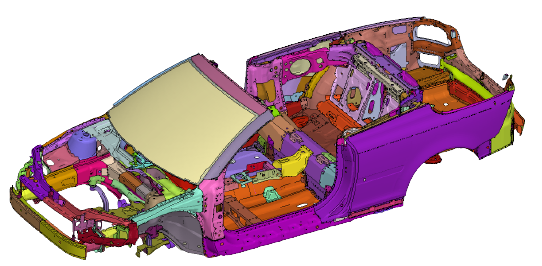Flexible Shaker
Our patented, in-house developed flexible test stand, designed for use on hydraulic shaker and actuator systems, enables realistic testing of components within the complete vehicle system.
The invention allows examination of the interaction between a vehicle body and components under test, such as doors, hatches, HV batteries, as well as front and rear ends.
It began with FSB Type 1, developed exclusively for convertible roof systems. Type 2 expanded the modular concept to accommodate sedans, station wagons, and SUVs. With FSB Type 3, designed for off-road vehicles with ladder frames, the replacement vehicles became increasingly realistic in terms of load-bearing structure positioning.
The tuning possibilities for both static and dynamic characteristics have also become more versatile. Types 4 and 5 represent the latest generations for battery-powered vehicles and conventional combustion vehicles, while Type 6 was specifically developed for electrified trucks.
Basic idea
The development of vehicle bodies and roof systems often proceeds independently, with suppliers and OEMs focusing primarily on their own systems. As a result, interface interactions are frequently not fully considered.

Body supplied by the OEM

Roof supplied by Supplier
The dynamic design is almost always carried out in a rigid environment (“rigid frame” or body cutouts), which leads to a falsification of the results.
The roof's natural frequencies compared to rigid systems are usually in the range of 20-30 Hz and, in the entire vehicle, generally coincide with the global modes, which are significantly lower. This results in a completely different result for the same excitation (e.g., measured at the main roof bearing).
FSB 1
The FSB 1 test bench was specially developed for convertibles in order to adjust the stiffness, wheelbase and mass of the respective car with the least possible effort and to integrate the customer objects including the necessary body environment (cubing).
FSB 2
The FSB 2 test stand allows testing of convertibles as well as all other vehicle types (sedans, station wagons, etc.). It is more complex than FSB 1, as it not only enables adjustment of the natural frequency but also the individual vibration mode of the vehicle.
FSB 3
FSB 3 is designed for simulating off-road vehicles with ladder frames and body-in-white mounted on rubber elements.
FSB 4
FSB 4 allows testing of all previously described components with a load-bearing HV battery.
FSB 5
FSB 5 is fundamentally similar to FSB 4, but its floor structure is designed for internal combustion engines.
FSB 6
FSB 6 is used for replacement vehicles for electrified trucks.

















